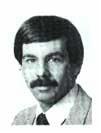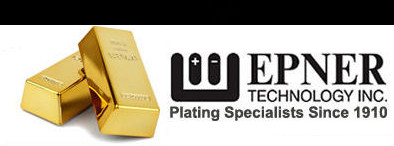 by Marty Borruso
by Marty Borruso
From Plating and Surface Finishing Magazine
ABSTRACT:
Surface finishing technology plays a key role in sophisticated weapons systems-both offensive and defensive- and plating quality can have a major impact upon shelf life and field performance of this high tech hardware. Here’s an interesting vignette about a small finishing shop in Brooklyn that has carved its niche in the area of high tech specification plating.
FULL TEXT:
Many man hours of engineering talent have gone into the development, fabrication and testing of specific plating systems to achieve either corrosion resistance, high temperature solderability, low electrical loss, or high infrared reflectivity, among others for application in sophisticated weapons systems. Frequently, more than one of these engineering functions will apply to the same part. The full payback of this engineering effort requires not only technical know-how on the part of the plater, but a dedicated quality philosophy as well.
One of the companies consistently “Pushing the envelope” in the development and production of some of the more critical plating procedures is Epner Technology Incorporated (ETI), a small contract job shop in Brooklyn, NY. ETI evolved from small jewelry and giftware plating business founded in 1910 to a high tech specification plating company with a worldwide customer list.
In 1938, Cohan-Epner, as the company was then known, was one of the first suppliers of silver plating for microwave “plumbing” for the earliest radar systems, one of many defense-related programs. In those days plating blister-free deposits on aluminum was a constant challenge. The company pioneered a procedure of brass plating over an aluminum substrate prior to copper plating.
ETI has aggressively marketed its surface finishing capabilities. In 1972, its booth at the Design Engineering Show at McCormick Place in Chicago caught the eye of an engineer from a Fortune 500 company. He asked if the company could consistently polish, nickel and gold plate an aluminum extrusion to withstand 450 ‘F without blistering.(The part was the extruded infrared fusing reflector on a large volume copier.) The gold plate had to meet critical reflectivity (then 91 percent at .7 microns) and hardness specs.
A long research program aided by the use of an infrared spectrophotometer produced a product of such quality that ETI was the sole supplier of this part for some 10 years, and hundreds of thousands of parts. When these copiers were eventually recalled, ETI’s refining division recovered and returned hundreds of thousands of dollars in gold to the company. This relationship triggered a growing awareness on the part of ETI’s management of the changing world of plating quality. It was the process that made a good part, not the inspector.
David Epner, president of ETI, said, “In the early days we found it hard to bite the up-front financial bullet that setting up the right process often required. The ongoing cost of strip and re-plate and the cost of a team of so-called inspectors (who were really sorting) seemed less painful than writing a check for the initial cost needed to install a reject-free process.
“SPC was another eye opener. On one long-running production job, five so-called inspectors were replaced by one person who actually inspected 20 pieces per hour, logged the results on an X bar R Chart, monitored the trend and was thrilled by her power to halt production if need be. Oh, yes, gold use was reduced by 30 percent.”
ETI Introduces Proprietary Gold Process:
In the mid 1970s, the growth of new and more sophisticated weapons systems, coupled with ETI’s growing reputation as a supplier of consistent, high efficiency infrared coatings; led the company to downsize and set as its main goal becoming the leading high-technology job shop in the country. A contract with another Fortune 500 company’s missile systems group was the beginning of a deep and widening involvement in production of the United States’ most advanced weapon systems. An anti-tank missile, for example, uses an infrared signal as part of it’s guidance system. The IR reflector, or “tail light” had been fabricated by a process known as optical replication. A die cast form, coated with an adhesive was pressed against a male optically shaped mandrel coated with a fragile vapor deposited gold film. The cured adhesive would lift the gold from the mandrel.
ETI proposed plating directly on the die cast substrate at one quarter the cost. This approach involved:
- A small die cast aluminum reflector was fabricated using optically polished spherical die inserts.
- The reflector was lightly polished prior to the deposition of 25 to 35 microns of a high phosphorous electroless nickel and color-buffed again after nickel.
- The final finish was.5 microns of a proprietary process developed by ETI known as Laser Gold®. (The name was chosen because of the widespread use of the process on Nd-Yag laser pump cavity reflectors.)
- The reflector required the development of a unique test instrument using a HeNe laser beam to scan a rotating sample. The amount of the reflected energy hitting a detector is indicated by a “pass” or “fail” lamp. As a result of tight process control and more than a 10-year learning curve, ETI has remained the sole source of this vital component for more than 500,000 units.
ETI’s gold process is currently specified on major infrared counter- measures programs, which offer aircraft protection from infrared heat seeking missile threats. The reflective efficiency in the functional IR wave- lengths today exceeds 99 percent, while maintaining a hardness greater than 150 Knoop. This permits physical cleaning of the surface.
Exacting Process Control:
“Our experience with our gold process has taught us the plating business,” said Steve Candiloro, operations manager of ETI. He is a chemical engineer and veteran of some 30 years in the plating “trenches.”
He added: “The key concept to our success has been ever-increasing respect for the value of process control in a job shop environment. Over the past 15 years, we have been amazed at the variety of process variables that affect reflectivity and hardness. Defining the variables is only part of the problem. How big is the ‘window’ for each variable? How does the process fit into that window? A properly equipped and staffed wet lab is essential to achieving this kind of process control.”
The process control discipline concepts that permit day-in and day-out production exceeding 99 percent reflectivity in the mid-IR on such varied substrates as aluminum, molybdenum, stainless, titanium, and beryllium (all gold-plated over a polished nickel), carry over to other ETI processes. For example, the lab plots the analysis of metallic impurities in its proprietary silver* process, a low loss, dense, microwave friendly coating. Trends are plotted between tight upper and lower control limits. The same for the electroless nickel variables such as sodium hypophosphite, nickel metal concentration, temperature and pH.
In the electroless nickels, weighed panels are continuously run so that the. platers are always aware of the bath’s plating rate during any particular process period. The matte acid tin bath has an upper control limit of .04 percent organics in the form of carbon. It rarely exceeds half that.
High Tech Clients:
ETI’s customer list includes highly visible and demanding – companies in the aerospace, electronics, optical and computer industries. “Some of the more interesting jobs we’ve seen are the ones that really must be done right the first time,” Epner said. “Often these projects are frightening because of the awesome value of the part to be plated and because there could be no stripping if there was a problem.
“An example of such a project involved a 40-inch diameter telescope mirror fabricated in pure beryllium. Our task was to strip the old nickel plating and replatethis priceless mirror blank with.004-in. minimum thickness of our optical grade electroless nickel. The plating had to be pit- and pinhole- free to ensure a perfect surface after polishing. That one didn’t get gold. However, we are gold-coating the smaller beryllium infrared secondary mirrors for the Keck Telescope in Hawaii.”
ETI’s success can be credited to the people who implement the company’s philosophy. Key staff includes three chemical engineers, one PhD chemist and one electrical engineer. The company brings a combined 120 years of technical plating experience to bear. The employees are given the “big picture” on the most important projects in the shop – where the hardware they’re plating goes, how it functions, and the function of the plating itself.
Epner talked about what the company has had to learn to become successful. “Most of our projects require engineering, and the hardest thing we’ve had to learn is to take the time to study the entire project. I mean really study it and then communicate with the customer to be sure we can actually do what the specifications require. The plater is usually at or near the end of the manufacturing process and there is a great temptation to short-circuit this process. You know the popular quote: ‘Never enough time to do it right….”
A Calculated Future:
ETI is expanding into a nearby 40,000- sq-ft building, but current plans favor keeping employee levels close to the present 50-person work force. The company’s approach to future growth is through the route of “strategic” partnership, which involves early engineering input in the design stage of a project. Epner believes specific parts would be more manufacturable and more cost-effectively plated if the design engineer could tap the know- how of the plater at the beginning – rather than at the end of the manufacturing process.
After the plating system is arrived at and tested in a pilot set-up, ETI dedicates production equipment and personnel whose goal is “six sigmas” quality while helping the customer become the lowest cost, quality producer in his market.
About The Author:
Marty Borruso, now a consultant to the finishing industry, previously was president of Plating Systems, Inc., Kearny, N J. He was affiliated with that company for more than 15 years. Mr. Borruso has a BS in forensic science from John Jay College of Criminal Justice. He is P&SF’s columnist for the “Finishers’ Think Tank.”
